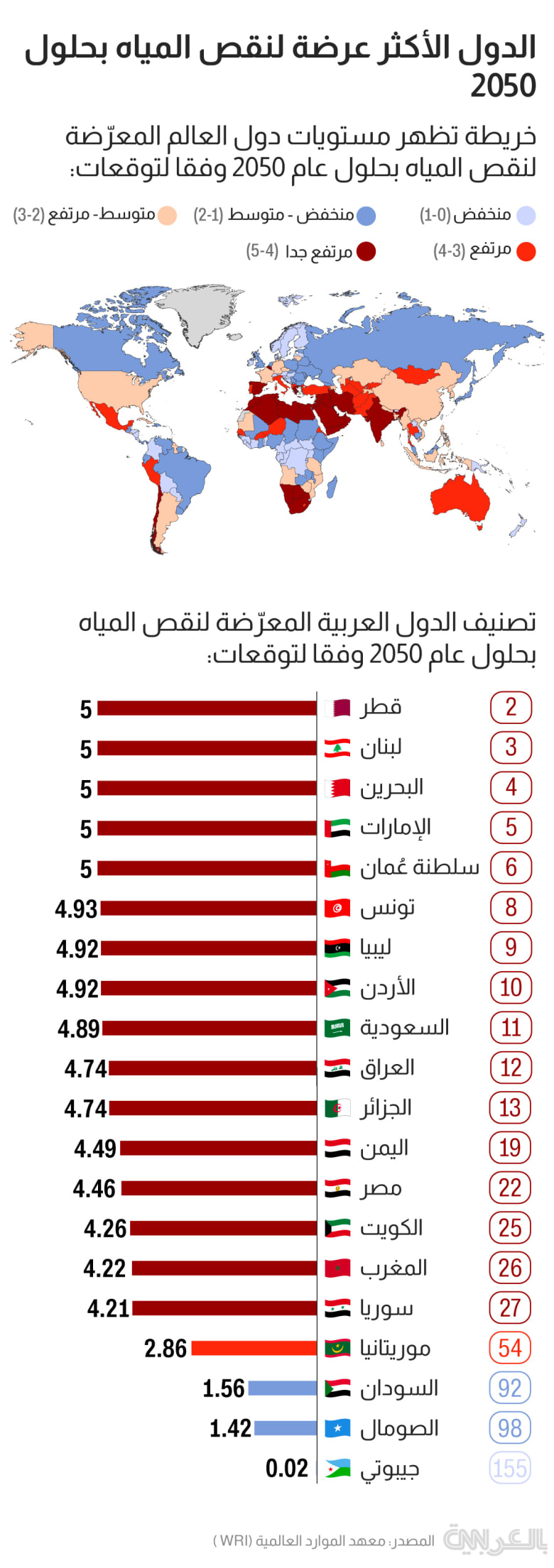دبي، الإمارات العربية المتحدة (CNN)—وفقًا لتقرير تنمية المياه في العالم لعام 2024 الصادر عن اليونسكو نيابة عن لجنة الأمم المتحدة المعنية بالموارد المائية، فإن التوترات بشأن المياه تؤدي إلى تفاقم الصراعات في جميع أنحاء العالم.
وفقاً للتقرير، لا يزال 2.2 مليار شخص يعيشون اليوم دون إمكانية الحصول على مياه الشرب المُدارة بشكل آمن، ويفتقر 3.5 مليار شخص إلى خدمات الصرف الصحي المُدارة بشكل آمن. وبالتالي فإن هدف الأمم المتحدة المتمثل في ضمان إمكانية الوصول للجميع بحلول عام 2030 لا يزال بعيد المنال، وهناك سبب للخوف من أن تستمر هذه التفاوتات في الاتساع.
وذكر التقرير بأنه ما بين عامي 2002 و2021، أثّر الجفاف على أكثر من 1.4 مليار شخص. اعتبارًا من عام 2022، عانى ما يقرب من نصف سكان العالم من ندرة حادة في المياه لجزء من العام على الأقل، في حين واجه ربعهم مستويات “عالية للغاية” من الإجهاد المائي، باستخدام أكثر من 80٪ من إمداداتهم السنوية من المياه العذبة المتجددة. ومن المتوقع أن يؤدي تغير المناخ إلى زيادة تواتر وشدة هذه الظواهر، مع ما ينطوي عليه ذلك من مخاطر حادة على الاستقرار الاجتماعي.
وتشير بيانات صادرة عن معهد الموارد العالمية (WRI) أن 25 دولة تتعرض حاليًا لإجهاد مائي مرتفع للغاية سنويًا، مما يعني أنها تستخدم أكثر من 80% من إمداداتها المائية المتجددة لأغراض الري وتربية الماشية والصناعة والاحتياجات المنزلية. وحتى الجفاف قصير الأمد يعرض هذه الأماكن لخطر نفاد المياه ويدفع الحكومات في بعض الأحيان إلى إغلاق الصنابير.
ووفقًا للبيانات (WRI)الدول الخمس الأكثر تعرضاً للإجهاد المائي هي البحرين وقبرص والكويت ولبنان وعمان وقطر. ويعزى الإجهاد المائي في هذه البلدان في الغالب إلى انخفاض العرض، المقترن بالطلب من الاستخدام المنزلي والزراعي والصناعي.
وأكثر المناطق التي تعاني من الإجهاد المائي هي منطقة الشرق الأوسط وشمال أفريقيا، حيث يتعرض 83% من السكان لإجهاد مائي مرتفع للغاية، وجنوب آسيا، حيث يتعرض 74% من السكان.
وأشارت التوقعات بحلول عام 2050، من المتوقع أن يعيش مليار شخص إضافي في ظل إجهاد مائي مرتفع للغاية، حتى لو وضع العالم حدوداً لارتفاع درجات الحرارة العالمية بما لا يتجاوز 1.3 درجة مئوية إلى 2.4 درجة مئوية (2.3 درجة فهرنهايت إلى 4.3 درجة فهرنهايت) بحلول عام 2100، وهو سيناريو متفائل.
وأضاف التقرير بأنه من المتوقع أن يزيد الطلب العالمي على المياه بنسبة 20% إلى 25% بحلول عام 2050، وبالنسبة لمنطقة الشرق الأوسط وشمال أفريقيا، يعني هذا أن 100% من السكان سيعيشون في ظل إجهاد مائي مرتفع للغاية بحلول عام 2050. وهذه مشكلة ليس فقط بالنسبة للمستهلكين والصناعات التي تعتمد على المياه، ولكن للاستقرار السياسي. ففي إيران، على سبيل المثال، تسببت عقود من سوء إدارة المياه والاستخدام غير المستدام للمياه لأغراض الزراعة في إحداث احتجاجات بالفعل ــ وهي التوترات التي ستشتد مع تفاقم الإجهاد المائي.
إليكم نظرة في الإنفوغرافيك أعلاه على تصنيف الدول وفقًا لتوقعات حجم عرضتها لنقص المياه في عام 2050.
